Fuel Your Campaign Strategy With Web Scraping

As a graduate with a degree in advertising and public relations, campaign strategy is something that I learn more about every day. There are many complicated aspects to advertising and PR campaigns that require data to help make informed decisions that hit the mark for the people engaged with your brand or organization. By utilizing data collection tools, your campaign strategy has the power to form itself with your analysis of the data you seek out.
There is no one-size-fits-all in campaign strategy, so allow yourself to learn how web scraping can help you form your campaign strategy. The table of contents below can help you skip to sections with the information most relevant to you.
Table of Contents
Breaking Down Campaign Strategy & Web Scraping

Campaign strategy is an organized, deliberate effort to create change in any measurable metric, dependent on thoughtful planning. In the world of marketing, advertising, and PR, it typically refers to efforts to grow your brand, business, or organization. The goals of campaigns could be to solve current problems associated with the brand. But, issues within a brand are not as easily recognizable as they seem without detailed data to analyze. But how do you gather data and locate these problems? The answer is through careful planning and data tools, such as web scraping.
Elements of PR campaigns
There are five main elements of a PR campaign to help you set goals for your organization. They’re relatively straightforward and involve:
- Knowing your target audience
- Setting attainable goals
- Developing smart messages
- Knowing your competition
- Remaining relevant within your market
What is web scraping?
In its most basic form, web scraping is the process of extracting data from websites. A web scraper will find and collect information for you from sites listed online and transfer it into a document when instructed. Typically, this document will be organized for you in a spreadsheet form, already organized for you.
This works through a bot that scrapes publicly available data from a specific website or through a keyword to collect relevant data. This data is then essentially copied and pasted and transferred for you, saving you a lot of time if you were to collect the data yourself manually.
There are many different ways to complete this, but in Scraping Robot’s case, you can use our premade modules to save you the time of learning how to program a bot. This way, you are entering in contextual information, such as keywords and specific website URLs you want to extract data from.
Questions to Ask When Campaign Planning
To begin taking action, you should know as much as you can regarding your current situation, who is affected by the campaign issue and its sentiments, what changes could make the situation better, and what resources, tools, and tactics are available to execute a campaign.
Once you have this information, then you start asking the following questions:
- What problem are you targeting?
- What will your organization look like once the problem is solved?
- What changes would bring your vision to life?
- Who are you trying to reach?
- Who will be affected if your campaign is successful?
These questions can act as a ‘fail-safe’ at each point of your campaign steps to ensure you’re not straying away from your goals. They are your greatest guide.
Integrating Web Scraping into Your Campaign Strategies

Here are a few ways to utilize a web scraper to gather data for use in your campaign plans.
Identify key stakeholders & monitor chatter about your brand
As defined by Wikipedia, a stakeholder is defined as “a group, corporate, organization, member, or system that affects or can be affected by an organization’s actions.” In short, anyone who is affected by the decisions and actions of your organization. Examples of a company’s stakeholders could be peers, superiors, co-workers, friends, family.
By identifying these stakeholders into demographic groups, you can cater to your messages and ensure that the right campaign messages will deliver across the board. But, how do you gather information on your stakeholders so you can identify these groups? You can start by web scraping profiles, reviews, and any other mediums where you can see people speaking about your brand online.
Scrape competitor data
Your competitors are one of your most valuable resources for data. Some useful points of data you should consider scraping from them are:
- Engagement of current and past campaigns
- How people are speaking about their brand
- Social media strategy
- SEO Strategy
Scraping these data points should be one of the first things you do before planning your campaign. If your competitors offer similar products that you do, you can learn from their mistakes. After careful analysis, correcting their errors to tailor your campaign better to your (and their) target audience can bring attention to your brand.
Understanding where your competitor’s brand has missed the mark presents a critical opportunity for your brand to fill your consumers’ needs. Now more than ever, people are outspoken on social media and are not afraid to share opinions on things that dissatisfy them. This can be for any content published, campaign strategy, and more. Utilizing a web scraper to gather this information for analysis can save you from your competitors’ mistakes.
Check results of campaigns
Completing goal planning is vital before determining what kind of campaign you want to run. Making sure your metrics of your goals are measurable is important too! Some examples of metrics that could be measured are:
- Customer engagement
- Brand awareness
- Customer retention
- Brand engagement
- Return on marketing investment (ROI)
- Visits to your website
- Content downloads
- Many, many more
There are many aspects of your business that you would want to grow metrics in, but ensuring you understand the methods to gather them is crucial. If you don’t know how to collect these metrics, you won’t analyze if your campaign strategy worked and can be utilized in the future.
Research other successful campaigns
While you want to research your competitor’s successful campaigns, you also want to explore other viral or successful marketing efforts that could be utilized for your campaigns. Searching out ideas to ensure you’re still delivering a unique campaign that leaves an impression is valuable. This could mean that scraping social media sites for currently trending topics and putting out content and campaigns related to those topics can garner more attention through those channels.
You already do this scrolling through and checking your personal social media channels, so combining that knowledge with data you scraped is easier than you think!
Complete market research
Gathering data from an entire market can be a hefty task. But, with web scraping, it doesn’t have to be! Breaking down your tasks into market trends, price monitoring, how others break into the market, and research and development into your products makes it a lot less daunting.
Scraping Robot has many great e-commerce modules, such as our Amazon! These can help you with the price monitoring aspect of market research, and gathering information in other areas can be completed with our HTML scraper’s help.
Generate content ideas
No campaign is complete without great content. Finding topics and keywords that will garner more attention from your target audiences will help you with your campaign’s brainstorming and execution.
For example, to seek out relevant keywords within your market or within a space you wish to infiltrate currently, you could utilize our Google scraper. For example, the #LikeAGirl campaign from Always was a successful PR campaign that took the feminist revolution that was prevalent in 2012. While this campaign ran for many years, finding topics to make a statement with content worked very positively for the brand.
You can do something similar to generate content ideas relevant to current hot conversation topics and trending memes online, for example. Web scraping can find this information no matter how in or out of the loop you are!
How to Run a Campaign with Scraping Robot Data

Besides saving you the time of collecting manual research, you can instruct our web scrapers to scrape the web every 60 seconds. This saves you even more time than conducting multiple scrapes a day and gives you the most up-to-date information possible. When you run out of your free scrapes per month, our pricing page will guide you in presenting the exact cost of the scrapes you’ll need, so budgeting is no problem.
Our site is easy to use, and our customer support staff is here to meet you halfway with any questions you may have concerning our service. Our team is eager to hear your thoughts and ideas concerning our modules and would love to help build you a custom scraping module for you to use while you’re campaign planning.
Final Thoughts
Deciding what kind of campaign strategies you want to take on relies on what sort of data you uncover. Scraping Robot can help you gather the most data possible for the most accurate results to fuel your campaign strategy.
The information contained within this article, including information posted by official staff, guest-submitted material, message board postings, or other third-party material is presented solely for the purposes of education and furtherance of the knowledge of the reader. All trademarks used in this publication are hereby acknowledged as the property of their respective owners.

